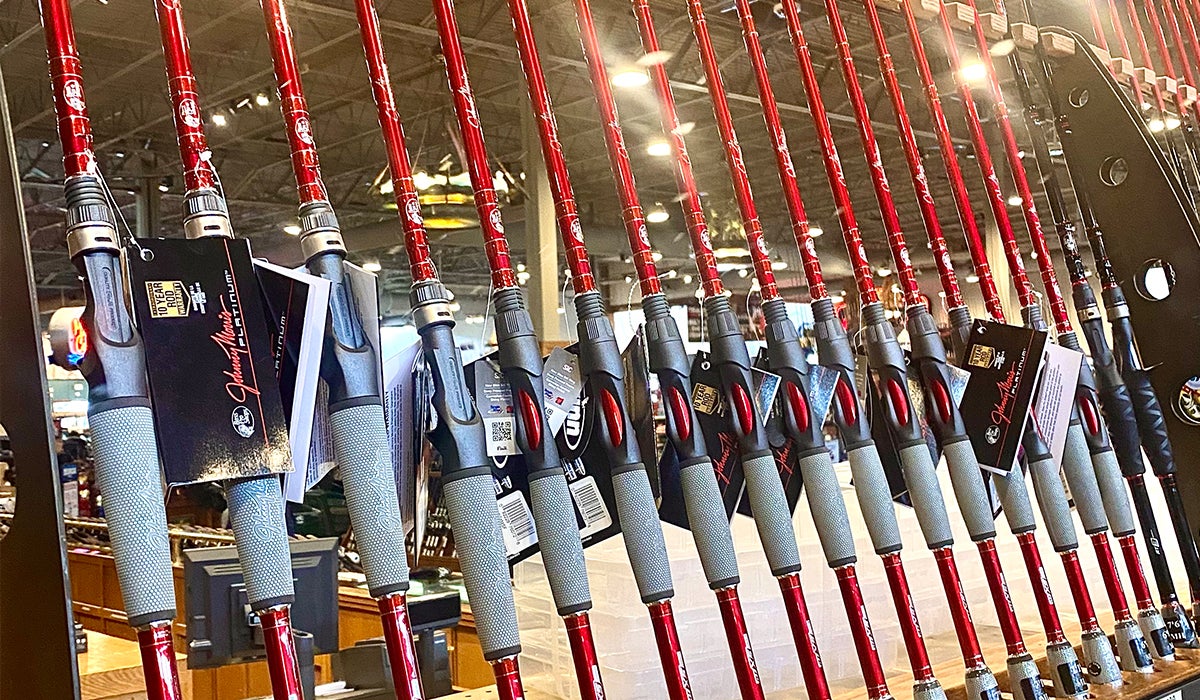
Our Editors independently research, test, and rate what we feel are the best products. We use affiliate links and may receive a small commission on purchases.
Fishing for fun is one of the most popular outside pursuits on the planet, and to take part, you need a fishing rod. This means that there are a lot of fishing rods out there, too. According to a University of Wisconsin study published in the Proceedings of the National Academy of Sciences, one in ten people in developed countries goes fishing for fun to at least some extent. That means there is a need for a lot of fishing equipment, with a fishing rod being front and center. If you’ve been to a sporting goods store or skimmed through the fishing rods sections of websites, you know that there is a wide range of rods available these days. How can you tell what the right rod is for your fishing needs? We talked to the experts to compile the angler’s complete guide to fishing rods to help sort things out.
Cover image by Derrek Sigler
Table of Contents
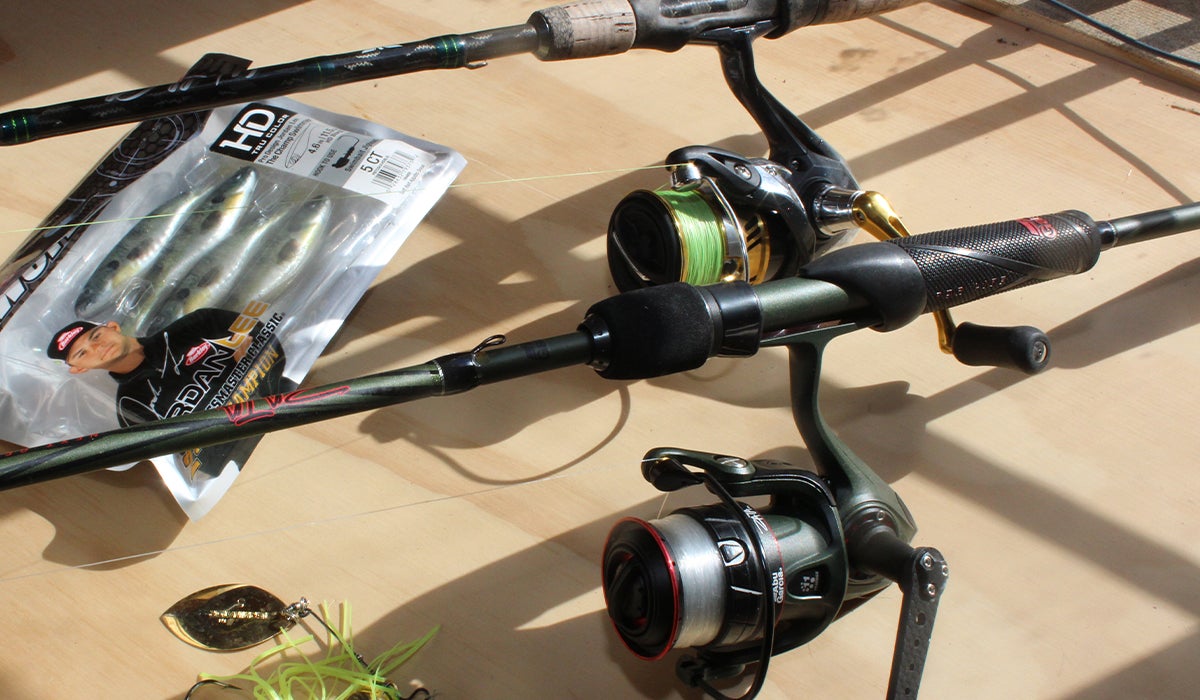
Clearing it up: Fishing rods or fishing poles?
The two words are used synonymously to mean the same thing, but which is the right term? While a fishing rod and a fishing pole might mean the same thing to many, there is actually a difference. A fishing pole refers back to the original idea of an extended pole with fishing line on it, that is used to catch fish. Technically speaking, a pole has the line attached only at the end of it. If you think of the old-style cane poles with line attached to the ends, being used to catch fish from the local pond, that is a fishing pole. Fly anglers may be familiar with a Tenkara pole, which is the same basic setup for fly fishing. The practice is common in tuna fishing in select countries, where commercial fishing boats lure big schools to the surface and fishermen line the edges of the boat using long poles with baited lines. If you’ve ever seen the videos of these anglers flipping the tuna out of the water and onto the boat behind them, this is a common form of fishing and a modern use of an age-old practice.
So, what is a fishing rod, then, compared to a pole? Technically speaking, a fishing rod is a pole with guide eyes attached to it and a reel that contains the line. This is the type of fishing equipment many of us are most familiar with. There are several types of fishing rods and various versions that are for specialized techniques. While there are a few variations of each form, fishing rods are basically broken down into three categories: spinning, casting and fly rods. This refers to the construction of the rod, the type of fishing, and fishing reel associated with it.
Anatomy of a fishing rod
A fishing rod and/or pole is a simple tool. In fact, it is basically a lever that is used to help give you additional power to handle the fighting fish. As the fish exerts force against you pulling it in, the rod/pole bends, and it is the force of the bend that helps fight the fish. The construction of the fishing rod helps to determine how this “lever” can help you with your fishing technique.
Blank
The blank is the main body of the fishing rod and is usually made from one of two materials – graphite or fiberglass. Graphite has replaced fiberglass as the most common material, although many fiberglass rods are still produced, especially for specialized fishing. There are other types of materials used for blanks, like bamboo for select fly rods, but it isn’t as common. Carbon fiber and Kevlar have also been used in extremely high-end rods, but are more commonly used as wrap materials in conjunction with specialized graphite blends.
Handle
This is the part of the fishing rod that you hold onto. A rod handle has a couple of parts, including the handle itself, which is usually made from foam or cork, and the reel seat, which is where the fishing reel attaches to the rod.
Guides
The guides are an important part of the fishing rod. This is what the line uses to go from the rel on the handle, out to the end of the rod. The guides are attached to the blank in a very interesting and extremely important way in that they are especially tied to the blank and then laminated in place. The way the guides are attached is actually part of the process that determines how the rod reacts to different fishing techniques.
Wraps
A blank is just a part of the rod, as are the guides. These two components are bonded by the wrap, which is various materials that are wrapped around the blank and laminated in place by various epoxies and resins. Wraps may include carbon fiber, kevlar, silk and other fabric materials. Carbon fiber and kevlar are popular in higher-end rods as they add strength, response and durability while keeping weight to a minimum.
Tip
The rod tip is the final guide and it actually serves to cap the end of the blank. Unfortunately, this is the most common spot for rod breakage. Thankfully, a rod tip can be replaced.
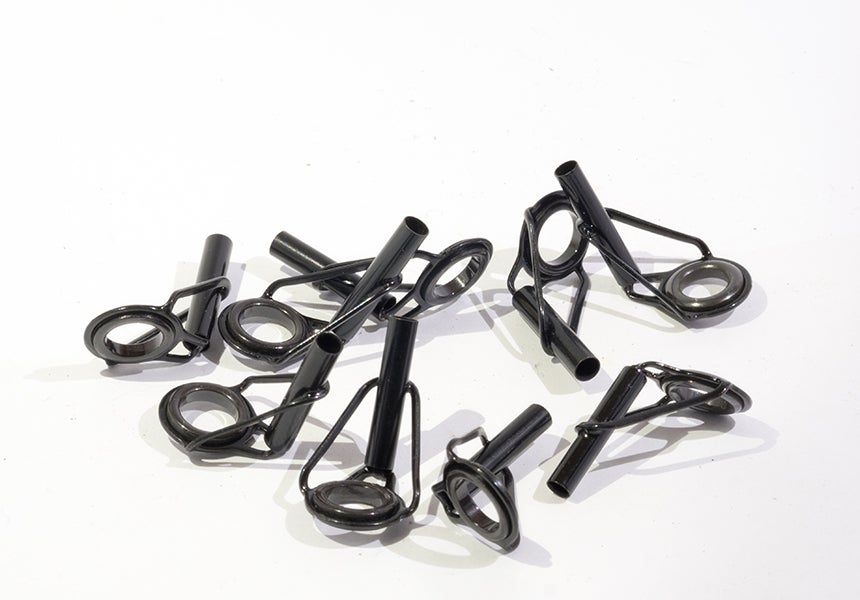
Types of Fishing Rods
Like we said, most fishing rods fall into three basic categories: casting, spinning and fly rods. These are the common types that you will find should you go searching for fishing rods on a website like Bass Pro Shops. From there, the rods are broken down into sub-categories.
Spin fishing, or spinning rod
When I was younger, we just called these open-face rods, because the face of the spinning reel is open, compared to a closed-face reel, like a Zebco. A spinning rod has the reel hanging below the handle, and the grip is usually designed so that your hand covers the seat of the reel against the handle. If you want to drive an experienced angler nuts, flip a spinning reel over so it is above the rod handle. It looks goofy, feels awkward, and cannot perform as it should. A spinning rod is easy to spot thanks to the guides that hang lower off of the blank than those of a casting rod. This is due to the spinning reel being further from the handle and the wide spin of the line as it is re-spooled as you turn the handle.
Casting fishing rods
Casting, or baitcasting rods, can be easy to determine from spinning rods by two key factors. One, the guides are smaller and closer to the blank. This is due to the line being spooled by the reel closer to the rod’s blank. Most casting rods also have some form of trigger built into the handle to give your hand a stronger contact point for making the casts. Baitcasting reels wind the line directly unto the spool in a straight line, which leads to some referring to casting reels as in-line reels, and hence, in-line rods. There is an exception to this with spin-cast reels, also known as closed-face reels like the popular Zebco. Many spincast rods have a specialized handle that is shorter and molded to fit your hand. These types of reels have a button in the back that you push as you start to cast the rod forward. The spool is covered and a small guide directs the line into the spool as you reel.
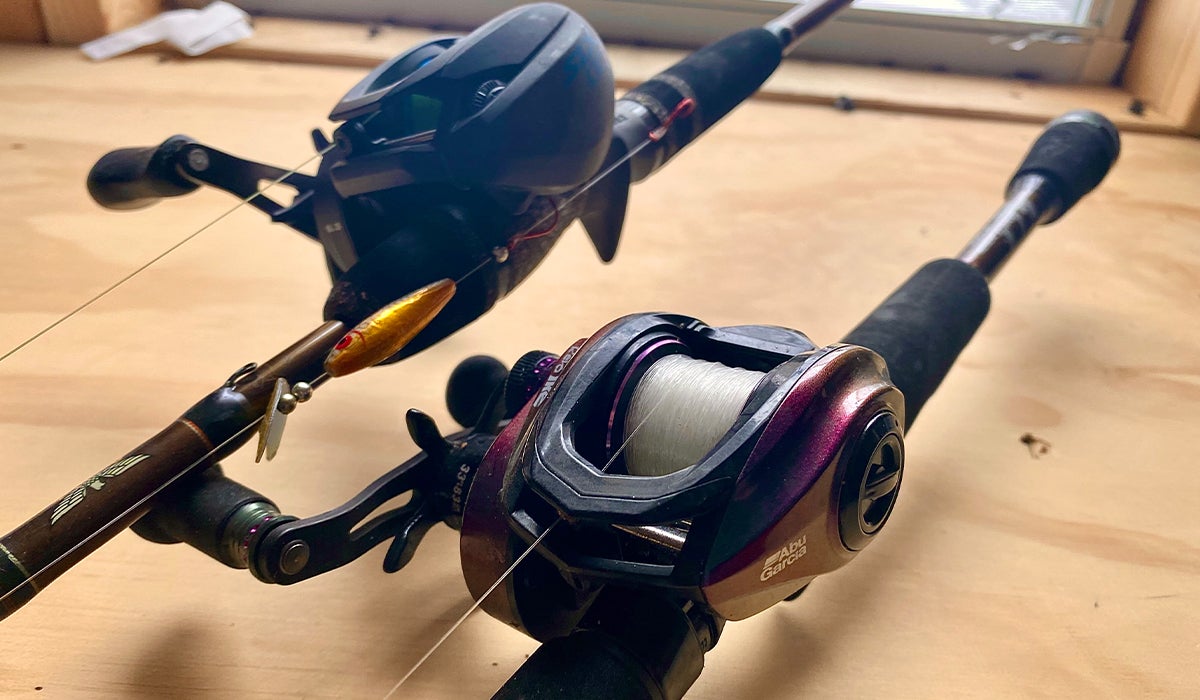
Telescoping fishing rods
A telescoping rod was a popular design a few years ago, and there are some pretty decent ones still around today. These are most often spinning rods that are designed to collapse into the handle as the blank is cut in sections. The sections fit inside of one another and hold in place when fully extended out. As most graphite blanks are hollow, the sections are cut with an exposed guide still on the outside. The guides then slide with the sections of blank and “lock together. Obviously, the main benefit of these types of rods is travel. Many expandable rods compact down to less than two feet in length, making them easy to slide into a backpack or even suitcase. The other option is a travel breakdown rod, where the rod sections aren’t contained within the next bigger section, but carried in a carry case. The same basic principle applies in that these are rods designed for travel, when you cannot carry a long rod with you. The main drawback is a reduction in overall rod strength. For anglers who want a certain amount of feedback from the rod, these types of rods offer less, as the blank itself, which is the main conduit for feedback from the actions under the water, is cut into sections.
Fly fishing rods
Fly fishing is vastly different from any other type of fishing activity. In fly fishing, you are using a lure of tied feathers, hair, and other materials that imitates an insect or other type of food source. However, unlike other types of fishing, you are casting the line, not the lure, as a fly by itself is very light. You also use more of the rod to fight the fish, so a fly rod is constructed differently. It is longer, and has a type of guide that works with the fly line, making it easier to cast. Fly fishing rods are often made from graphite, like other rods, but bamboo is a natural source material and it has many of the same properties as a graphite rod blank. Many fly rods are eight to nine feet in length, or more, so they are often cut into several sections for packability.
Tenkara poles
A Tenkara pole is an expandable fly fishing pole that has no guides or reel seat in the handle. It doesn’t use a reel and instead has a loop that the fly line and leader attach to at the tip of the pole. This gives the angler a limited amount of line to cast and makes for a challenge when fishing bigger waterways. However, due to the limits of the line length, these poles are very handy for fishing in smaller, harder-to-fish locations, like small creeks. Because the line attaches to the tip of the pole, a Tenkara fly pole is technically a pole, and not a true fly fishing rod.
Ultra-light fishing rods
An ultra-light fishing rod is a specialized type of rod used mostly for panfish. It is a smaller rod that is extremely flexible and designed to be used with lighter line weights and smaller lures or bait. Most ultra-light fishing rods are 4.5 to 5 feet in length and are made with a highly flexible blank. These types of rods are popular with anglers looking to make the hard-fighting, but small panfish feel like a much larger fish is on the other end of the line. Fishing with an ultra-light fishing rod is fun, especially if you plan to keep some fish to eat. The drawback to using one are that it can take longer to reel the fish in, which can tire the fish out more, making the release a little more difficult should you opt to let it go. You need to make sure the fish is revived before you let it free. Another feature that can be a bit troubling is when you inadvertently hook onto a bigger fish, like a larger bass or pike. This is something I have had personal experience with and it can make things tricky to land the fish without it either breaking the line or breaking the rod – both of which have happened to me.
Surf fishing rods
Surf fishing is a highly specialized form of fishing and just as the name implies, you are casting into the surf, from the shore, and mostly on the ocean, although there are surf anglers that do the same type of activity on the Great Lakes. Surf rods are extremely long, as the cast is going to be quite a feat, and are often spinning rods with large saltwater spinning reels. Surf anglers often use a large bait and a hefty weight to get the line as far out into the water as possible. To make things happen, the rods are long and highly flexible, with rods being 10-15 feet as common place. One popular tactic is to use a paddleboard to carry the bait out past the surf zone, where braking waves can and will pull the bait back to the shore. Depending upon the species of fish being targeted, the rod itself can be very heavy duty, as many surf anglers target sharks. As you can imagine, reeling in a 8-10 foot shark that weighs several hundred pounds takes a serious rod.
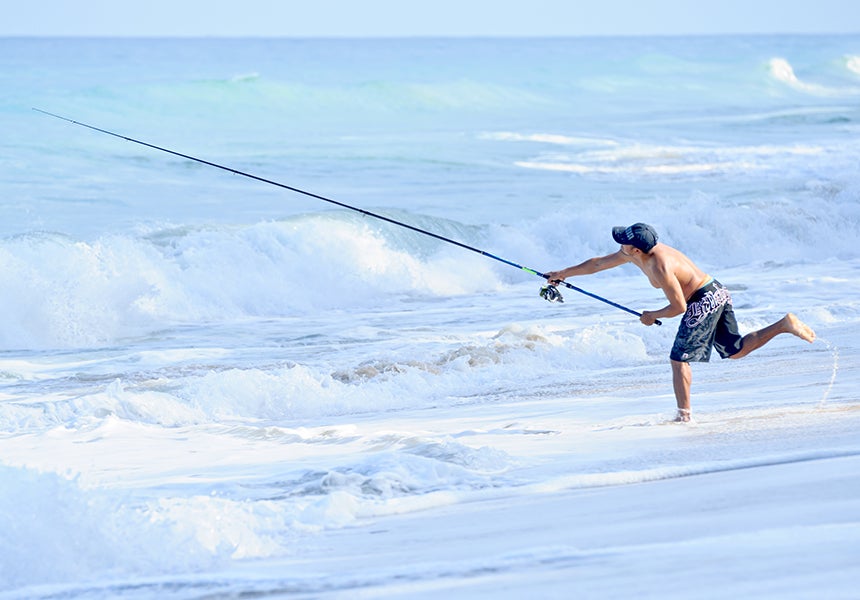
Trolling rods
Trolling is a style of fishing designed to cover a lot of water in a short amount of time. To troll, you set out lines with lures or bait are various depths, and use the boat to move across the water, therefore covering the most amount of water possible. This is a popular technique for chasing schooling fish, like salmon, walleye, and more. As you might expect, it takes a specialized fishing rod type, with most trolling fishing rods being set up similar to a casting rod, as the reels tend to be level wind types. The handles are elongated to fit into rod holders and the length is also a bit longer to give better action to the lure and to provide some additional play to the action when the bait or lure has a fish on it.
Jigging rods
Jigging, or vertical fishing, is a type of fishing that is less about pulling a lure through the water, and more about giving the lure and bait motion along the bottom, or at a given depth. A jigging rod can be a spinning rod, baitcasting rod, ice fishing rod or even an overhead rod. Whenever I have fished for halibut in the northern Pacific ocean, we have jigged along the bottom for these big, flat fish using an overhead rod. Jigging rods tend to be sensitive to feel subtle hits.
Ice fishing rods
Ice fishing rods are another extremely specialized form of fishing rod. These are short rods made to be used inside of an ice shanty, where space is limited. Since ice fishing is done through a hole drilled into the ice, there is no need for casting. The rod blanks are often solid graphite and are either limber for catching panfish and perch, or stout and slightly longer for walleye, trout and pike. The handles are often a little different as well, with the reels not always completely secured to the handle. Most ice fishing rods are set up like a spinning rod, with the guides on the bottom side of the blank.
Overhead rods
Overhead fishing rods are most often used when fishing from boats and are designed with the reel on top of the rod. Much like a casting or trolling rod, the guides are on the top. However, the guides have close spacing to ensure to not let the line touch the rod blank. The guides themselves are often rollers, to make sure there is no undue tension or friction placed upon the line. These rods are short and very stout and are often used for serious gamefish species like marlin, swordfish, halibut and tuna. Everything about an overhead fishing rod is overbuilt and most have handles designed to fit into specialized fighting belts, chairs or even just to be kept in the rod holder on the side of the boat.
Kids’ rods
Kids’ fishing rods are often designed to keep the younger kids interested in the sport. They are often inexpensive, as they don’t often last very long. These rods often handle a built-in reel and can have cartoon characters as part of the motif. The biggest downfall to a kid’s fishing rod is longevity. These are rods that are made to catch interest, but seldom last long.
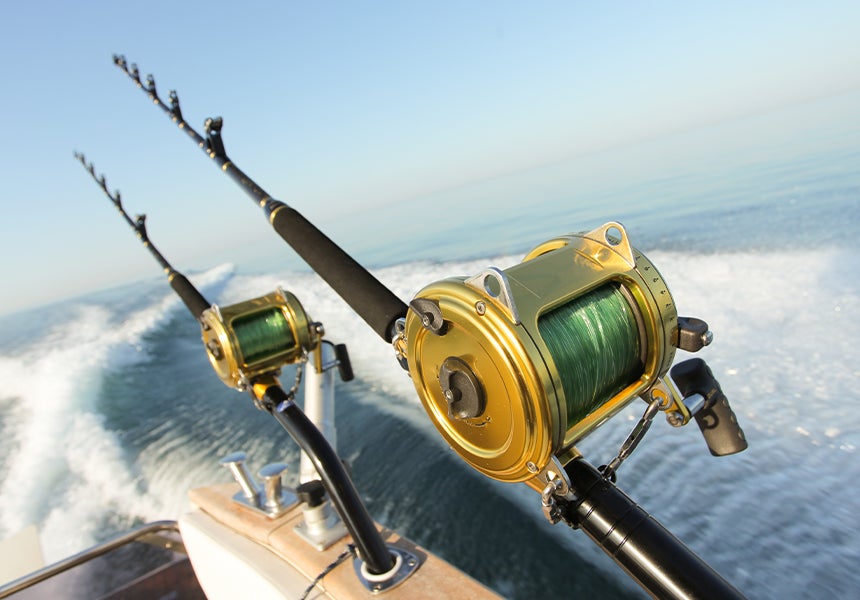
Fishing rod actions
You’ll often see that fishing rods are designated by not only the length of the rod, but the action and power of the rod as well. When you pick up a rod and see that it is a 7ft, fast action rod, followed by a heavier line weight rating, this tells you a lot about the rod. Think of the rod as a spring, because it kind of is in that it will react to pressure and then return to its normal shape. Keep in mind that the action doesn’t really relate to sensitivity.
Fast-action
A fast-action rod will react very quickly to force and use the kinetic energy in the blank to return to its normal shape. A rod that reacts fast will respond well to a hook set. Fast action means that the rod doesn’t bend as far down the rod. Any application where you need to move a bait or a fish away from cover quickly requires a fast action rod
Moderate Action
Anglers going after big aggressive fish species tend to gravitate towards moderate action fishing rods. These rods have a longer flex. Moderate action rods don’t cast further than fast action rods. Just like a long bow doesn’t shoot an arrow faster/farther than a compound bow. Moderate action is something you want for keeping fish on the line, or for the action you want to impart to a bait, like a treble hook crank bait. The fish will shake his head and jump and the rod will absorb more of the energy and help to not let the fish use the pull on the line as a crowbar to help dislodge the lure. It also helps in allowing the fish to get the lure in its mouth and turn before the line comes tight so the hooks set in the right spot in the fish’s mouth.
Slow action
Slow action fishing rods have an obvious slower reaction time. This helps with smaller bait presentation. There are variations of these actions with combinations and more depending upon what types of materials are used for the rod building processes.
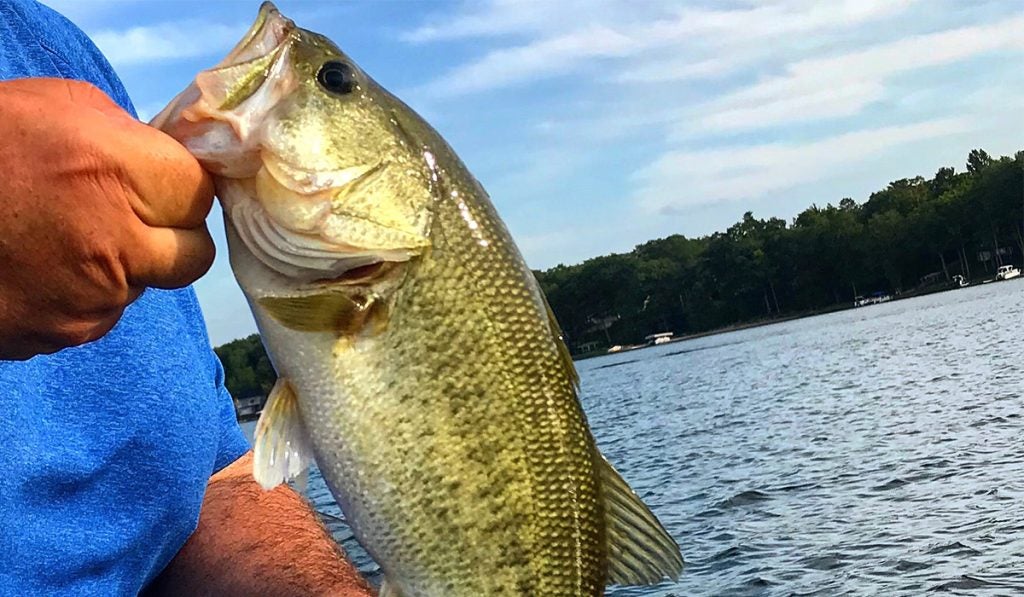
One of the author’s favorite bass rods is a medium-light spinning rods that he uses for finesse fishing Berkley Powerbait worms. Photo by Terry Sigler
Fishing rod power
Power and action are often used interchangeably, and this is not accurate. Power is how hard you can pull and how much a rod can lift. Action is when the rod gets into the power. Faster action means the power starts closer to the tip. Slower means the power starts closer to your hand. This is really important to understand.
One term you see often when referring to power is backbone. A rod’s backbone is the amount of rigidity the blank has built into it, so one with more backbone has less flex.
Light and Ultra-Light rods
A light, or ultra-light power rod won’t have as much backbone and will offer more flexibility. These are great for fishing smaller, aggressive fish, like panfish. These rods can be anywhere from slow to fast action, depending upon the manufacturer and the lure choice.
Medium-light
As you would expect, these rods are right between light and medium rods. One of my favorite rods for finesse fishing soft-plastic worms for bass is a 7ft, medium-light spinning rod.
Medium rods
Medium, or commonly referred to as “medium action,” rods sit right in the sweet spot between the two ends of the power spectrum and you’ll see that there are more medium power/moderate action rods sold/produced than any other just because they can be used in such a wide range of conditions.
Medium-Heavy
These rods fit that sweet spot between a medium rod and a heavyweight, and give you extra oomph for aggressive fish.
Heavyweight rods
Heavyweight rods tend to be moderate or fast and have a lot of backbone, but this is not always the case. It is all based upon the application. A heavy rod set for aggressive fish, can be moderate action, so it has a lot of backbone, but a slightly slower reaction time, letting you cast with ease and cover more water.
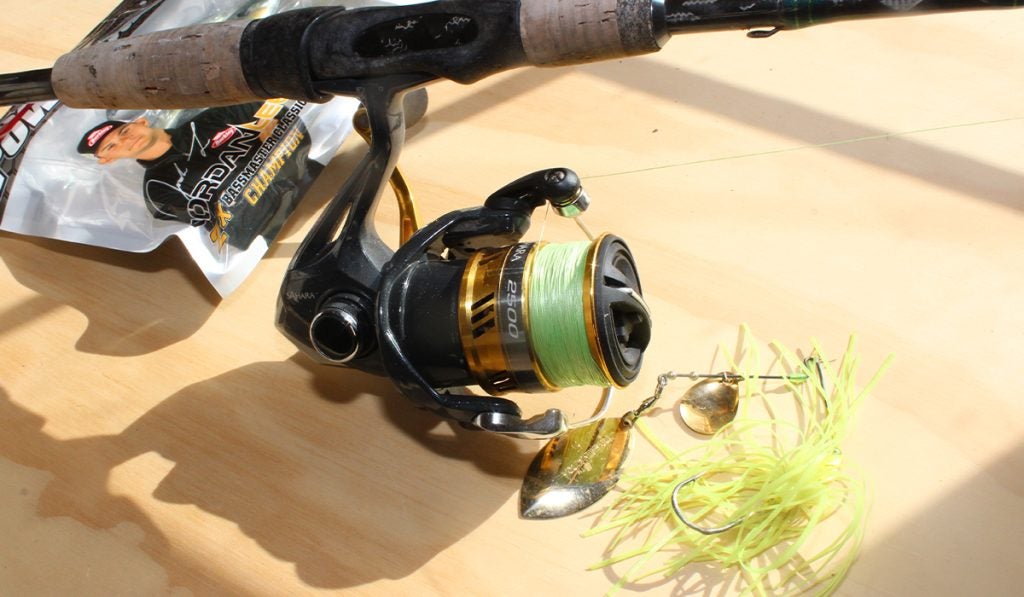
How a fishing rod is made
A fishing rod is a collection of materials, but it is more than that. There is a certain amount of craftsmanship and design that goes into developing a fishing rod. When looking at how rods are designed and made, the process for selecting toe materials begins with looking at the use according to Justin Poe, Director of Fishing Rods for Pure Fishing, one of the largest manufacturers of fishing equipment. Pure fishing owns such brands as Berkely, Abu Garcia, Fenwick, Ugly Stik and more.
“Materials for rods are chosen based on the intended purpose of the rod and in what region,” said Poe. “Blank materials, graphite and fiberglass are the main two materials used, and the resin ratio and type are also a factor. Higher modulus/PSI material is stiffer by weight, so heavy action rods tend to use a higher modulus graphite.”
Selecting the fishing rod blank
For selecting a fishing rod blank, Poe always starts with the intended application and style of fishing.
“If I am throwing a mid-depth crank bait around hard (rocks/wood) cover, I want a rod that is a bit slower action with a deeper flex than I would want around softcover like weeds or vegetation,” he said. “For hard cover, if your rod is too fast you would bury the hooks in the wood or rocks and if it’s too slow for fishing around grass you wouldn’t be able to clear the weeds from the hooks to complete your retrieve.”
This is just one example Poe gave when discussing the construction of one fishing rod. As you might imagine, with there being so many different scenarios you could/would encounter while fishing, there are many examples.
Line guides, for example, are selected depending upon the application and intended use as well, Poe said. The different line types, like monofilament, braided lines and fluorocarbons, as well as the type of water will dictate which frames and ring materials are used. Saltwater rods often see more abuse than freshwater rods due to the corrosive properties of the environment, not to mention the abuses of fighting ocean-going fish species. However, certain freshwater applications are very demanding on guide rings and materials as well. Braided lines are notoriously hard on guides, and have been known to cut through materials not rated to handle the line choices, Poe added.
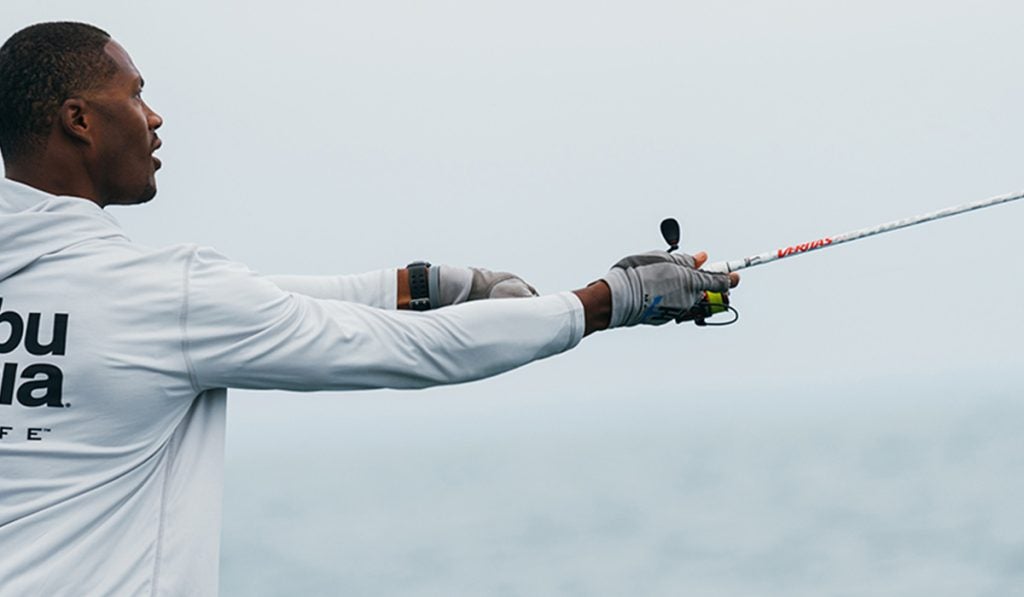
The construction of the rod tells a much bigger story than the components themselves, too. The core of any fishing rod is the blank upon which it is built, but it is more than the blank alone that should help you determine which rod is best for you, according to Poe.
“Unfortunately, I wouldn’t advise anyone to choose a rod based on a number or a listed modulus rating or PSI tonnage rating of the blank alone,” Poe said. “I don’t think it tells the story alone. If you look at available materials to build a blank from there are really only about 12-15 variations. When you look at all of the rod manufacturers and listed out all of the materials they use, including the resins and other materials, that number jumps into the hundreds. I am not trying to purposely complicate this. There are just a lot of variables to consider.”
A fishing rod needs a reel
And a rod alone is not the whole picture. Once you have a rod in hand, mount your reel to it with fishing line on the spool and see how it fits, how it balances and how it feels. Yes, the line will change the balance point, something that Poe said is a very important factor. He suggests that if you find a particular rod you are happy with, use that as a starting point for collecting other fishing rods based upon various techniques.
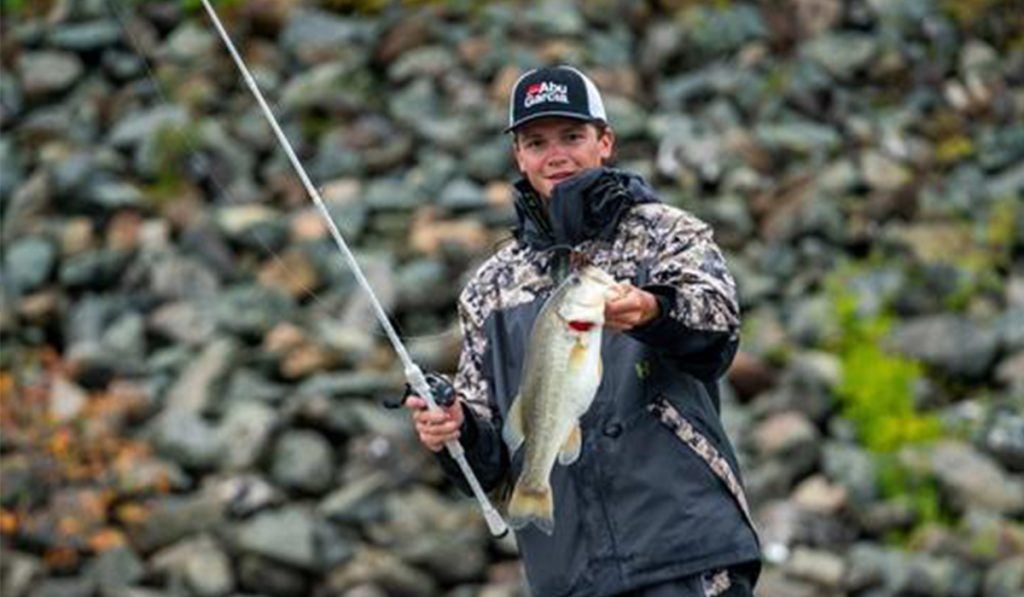
“If you love the Abu Garcia Veritas Tournament VXTC73-6 (Medium heavy) rod, but you need a rod just a touch heavier then you are also going to love the VXTC73-7,” Poe said. “Good brands have good action discipline across a line and the rods within that line have a shared personality. It isn’t always true, but if you find a rod you love, look within the brand to find the next lighter or heavier. The same can be said when you go up and down the line. If you want a rod with a little more sensitivity, lighter weight, or nicer components. Move up a level and you can usually get it.”
Misconceptions about fishing rod construction
There is a very big misunderstanding about how fishing rods are perceived based on the materials used in the construction. In fact, rod design and manufacturing are more important than the material will ever be, according to Pure Fishing’s Poe. This is very true. You can pick up two fishing rods that are both made using the same 30ton blank material, with the same length, action, line-rating and even the components from two different but very reputable manufacturers. The two rods will be identical on paper, yet the rods can and most likely will feel totally different. How can that be? It’s all about how it is put together.
This isn’t saying that the companies are necessarily misleading you about the materials used. Not at all, according to Poe. The truth is, the mandrels, patterns, resin-ratios, or even the actual manufacturing process are quite often different. And then you add in how the rod feels compared to how it is intended to feel, which is even more hard to track. It very well could be that “Brand A’s” rods take on a different interpretation than what “Brand B’s” rods for what a 7-foot, medium-heavy, Texas rig worm rod might be.
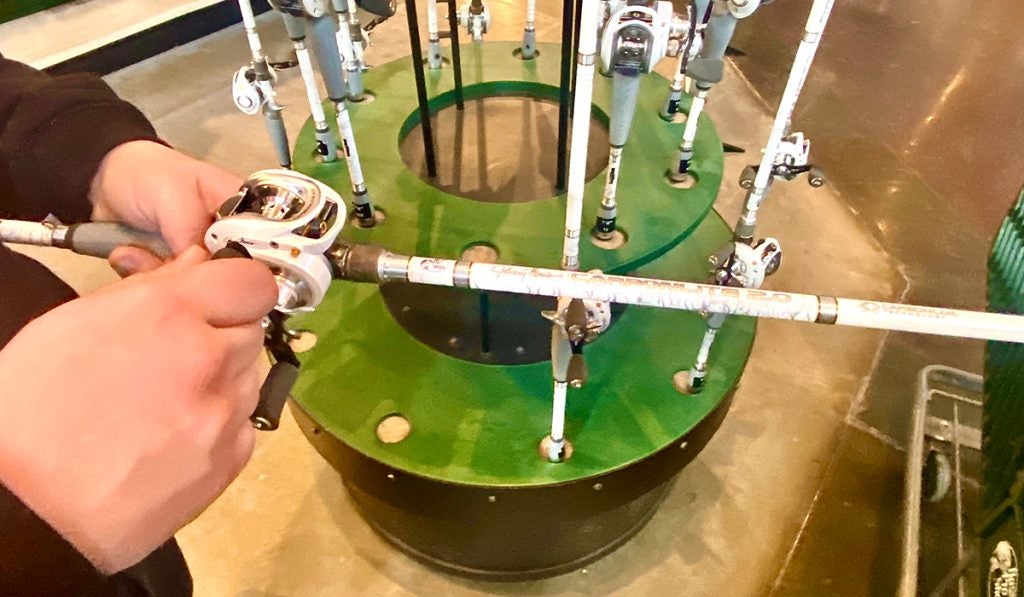
“I know this gets confusing but this is also what makes rods awesome,” said Poe. “Neither one of these manufacturers is wrong. The reason they aren’t wrong is that the same baits get fished in Texas/California/Kentucky/Florida/ (Insert your state here)… different. Different cover, depth, and whatever the situation is, it’s always different.
One thing that also goes into building a fishing rod beside the components, and that is time. You have to combine the experience behind the rod design along with the components and it all comes together in a fishing rod to enhance feel and performance, Poe said.
“It’s a hard balance,” he said. “The blank is the most important part of the rod – hands down – but it is the most mysterious and most misunderstood for all the reasons previously mentioned. The blanks start out incredibly light; they are usually very crisp and light. Nothing is more pure than the blank. But a blank alone is unfishable.”
The choices you make as the angler and consumer here will make or break the rod. Every single thing that gets attached to the blank will make the blank less sensitive and heavier – Even paint. You have to decide what is important to you and how you plan to fish.
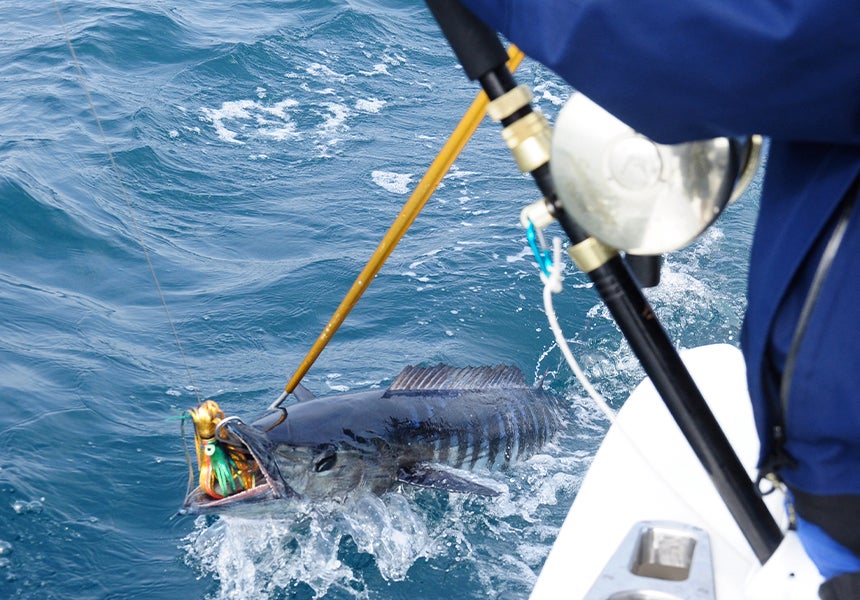
Another misconception about rod construction has to do with two-piece rods versus one-piece rods. A two-piece rod breaks down in half for easier transport. A sleeve and additional materials are added to the blank during the construction phase to let the rod blank be cut in half. The old wive’s tale was that a two-piece does give you the same sensitivity or feel as a one-piece rod. Poe said that is no longer the case and that modern two-piece rods give the same feel and reaction as any single-piece rod.
FAQ
What is the best fishing rod?
As you might expect, the best fishing rods will be what you like and what fits your fishing style. As you gain experience, you’ll try new techniques and will undoubtedly learn more about what you like from a fishing rod for a given practice.
How much does a fishing rod cost?
Pricing for fishing rods is a huge variable and depends almost entirely upon how much you want to spend and what you want the rod to do. Fishing rods usually start out in the $25-35 range, and the pricing does up from there, to over $1,000 or more depending upon how specialized the rod is. Technique-specific rods cost more because more goes into the development, and as you go up in component quality, those costs go up, too. For most, experience will often dictate how much you want to spend on a fishing rod.
What is the best fishing rod for a beginner?
For most adults, the best fishing rod for a novice angler would be something like a 6-6.5 foot, medium/moderate action spinning rod. A spinning reel is quite easy to master and a medium rod does enough types of fishing well enough that if you only had one fishing rod, that would be the best place to start out.
Which is better a baitcaster or a spinning reel?
Trying to decide which is better between a baitcaster or spinning reel is a matter of choice, tactic and experience. You can fish both effectively with just about every technique, but if you’re not experienced with using a baitcasting reel, then you should consider practicing for some time in the yard before you go to the lake. You control the action of the spool with your thumb, and this includes hitting the brakes when the line reaches the water’s surface. If you don’t do that, the line will continue to strip off the spool, but it no longer comes off the rod, meaning you get what we commonly call a bird’s nest – a pile of tangled, useless fishing line that clogs the reel and makes for no fun.
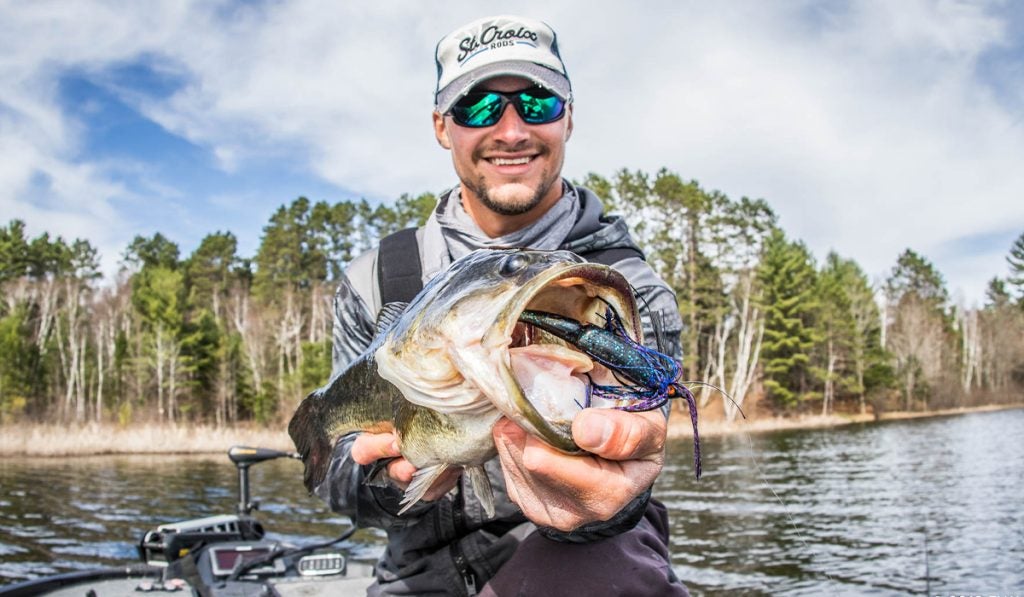
How do you pick a fishing rod and reel?
You pick the right fishing rod and reel by practice, technique and personal preference. As you gain more experience, chances are you’ll wind up adding more rods and reels to your collection.
How much is a good fishing rod and reel?
A good fishing rod and reel should cost whatever you’re willing to pay for it. I know that’s leaving a lot of open territory, but you have to decide just how much you’re willing to spend, and this is often based upon experience. With current fishing technology, however, you should plan to spend at least $35-$55 for a good basic rod and reel that should last for some time.
What fishing rod size should I get?
If you are just starting out, or don’t spend a lot of time fishing, you should strongly consider getting a 6-1.5 foot fishing rod to start with, in a medium-power. This is a good “all-around” fishing rod size.
How do you set up a new fishing rod?
You should match an appropriate reel to your new fishing rod and set it up with the appropriate weight fishing line. If you’re rod is rated for 6-12lb. Rated line, pick a line in that range, like 10lb. for example. Spool the line onto the matching reel and add enough to reach the full line on the spool. Never overfill the spool on the reel, as this causes the line to tangle quite often. Run the end of the line through the guides on the rod and tiea lure, hook or swivel onto the end of the line so that it can be held tightly when reeled. You should keep a small amount of tension on the line to keep the line on the spool tightly.
